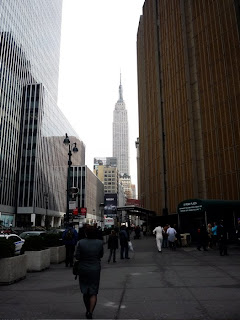Walking Broadway with Abraham Lincoln: The Visit to New York for the Cooper Union Speech
 Anyone who has ever traveled to a large unfamiliar city for the purpose of an important job interview and who might be a little anxious about the big job talk itself and what to wear and meeting new people should be able to imagine themselves in Abraham Lincoln's shoes as he strolled up Broadway on the afternoon of February 27, 1860. Imagine, too, if you look a little different than most people, tall and gangly in this case, a tad nervous about your appearance and somewhat concerned that you'll come off as a little too country in a crowded city of sophisticates. And add to this, a forecast of rain and snow in a city of already filthy and slushy streets. I actually experienced this very thing myself a few years ago, but I wasn't trying to impress people that I might make a good candidate for the Presidency of the United States of America.
Anyone who has ever traveled to a large unfamiliar city for the purpose of an important job interview and who might be a little anxious about the big job talk itself and what to wear and meeting new people should be able to imagine themselves in Abraham Lincoln's shoes as he strolled up Broadway on the afternoon of February 27, 1860. Imagine, too, if you look a little different than most people, tall and gangly in this case, a tad nervous about your appearance and somewhat concerned that you'll come off as a little too country in a crowded city of sophisticates. And add to this, a forecast of rain and snow in a city of already filthy and slushy streets. I actually experienced this very thing myself a few years ago, but I wasn't trying to impress people that I might make a good candidate for the Presidency of the United States of America.
Lincoln, who was relatively unknown to New Yorkers at this time and not yet the official nominee of the young Republican Party, worked hard finishing his speech, the one he was to deliver that night at Cooper Union. He arrived in New York two days before, finding his way by himself to Astor House, John Jacob Astor's hotel on Broadway between Vesey and Barclay Streets. The hotel, just across the street from City Hall, was a beautiful five-story Greek Revival building with gaslights and bathing facilities on each floor. On Sunday morning, Lincoln took the ferry over to Brooklyn to Plymouth Church to hear Henry Ward Beecher preach from the pulpit. Though invited to visit with locals after the service, he explained he needed to go back to the hotel and work on his speech.
The speech later that night went well. The vast hall of Cooper Union, constructed just the year before, was filled with 1500 people, each paying twenty-five cents, although the hall wasn't full. Lincoln gave a nuanced historical speech about the intention of the Founding Fathers regarding the extension of slavery into the territories. In the hour-long speech that's mostly dull and unquotable, he argued that most of the framers of the Constitution supported the right of Congress to regulate slavery in the territories. The audience members, many of them influential in the press, thought Lincoln, although very awkward in appearance and speech, was onto something. The New York Times ran the text of the speech on its front page the next day.
After the speech, two members of the Young Men's Central Republican Union escorted Lincoln to their club, the Athenaeum (on the site of the present-day building at 110 Fifth Avenue) for an informal supper. After dinner, he and Charles C. Nott set out on foot for the long walk down Broadway to the hotel. Nott noticed that Lincoln was having difficulty walking and asked him, "Are you lame, Mr. Lincoln?" Lincoln replied that he had on new boots and that they hurt him. They then boarded a street car. Nott got off at the stop near his house, leaving Lincoln to ride alone back to Astor House.
"The impression left on his companion's mind as he gave a last glance at him in the street car was that he seemed sad and lonely and when it was too late, when the car was beyond call, he blamed himself for not accompanying Mr. Lincoln to the Astor House — not because he was a distinguished stranger, but because he seemed a sad and lonely man." *
When you find yourself walking on lower Broadway and your shoes hurt, you may want to keep this story in mind.
Images of Cooper Union (East 7th St. to Astor Place) and lower Broadway by Walking Off the Big Apple. Picture of Abraham Lincoln by Mathew Brady. A few days later, Brady's portrait was published on the cover of Harper’s Bazaar with the caption, “Hon. Abram [sic] Lincoln, of Illinois, Republican Candidate for President.”





This is such a cool thing to be able to do. If walking the streets of New York wasn't rewarding enough, knowing the history behind each step is so, so valuable. Thanks!
ReplyDeleteoh great story, thanks once again.
ReplyDeleteAs I don't want my new boots to hurt me next month, I started wearing them today ;)
Merci, Pascale.
ReplyDeleteI loved this one--and I know the feeling with the boots! In my extreme youth I wore high heels running around New York, but now that my youth is less extreme I'm with Pascale and try to wear moderate footwear.
ReplyDeleteHappy Lincoln's Birthday!